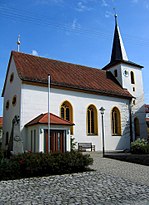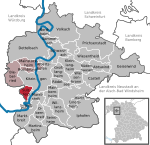Kitzingen
Kitzingen (district)Pages including recorded pronunciationsPages with German IPAPopulated places on the Main basinPopulated riverside places in Germany ... and 1 more
Towns in Bavaria

Kitzingen (German: [ˈkɪt͡sɪŋən] ) is a town in the German state of Bavaria, capital of the district Kitzingen. It is part of the Franconia geographical region and has around 21,000 inhabitants. Surrounded by vineyards, Kitzingen County is the largest wine producer in Bavaria. It is said to be Franconia's wine trade center.
Excerpt from the Wikipedia article Kitzingen (License: CC BY-SA 3.0, Authors, Images).Kitzingen
Schwimmbadstraße,
Geographical coordinates (GPS) Address Nearby Places Show on map
Geographical coordinates (GPS)
| Latitude | Longitude |
|---|---|
| N 49.733333333333 ° | E 10.166666666667 ° |
Address
Schwimmbadstraße
97318 , Etwashausen
Bavaria, Germany
Open on Google Maps









